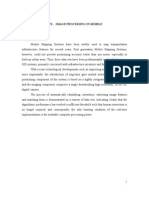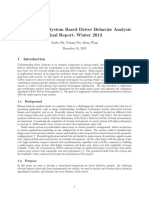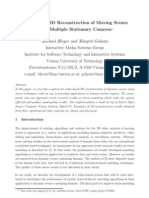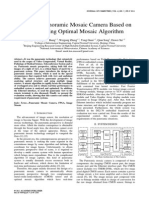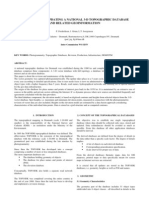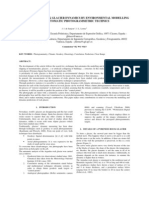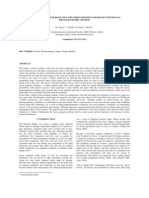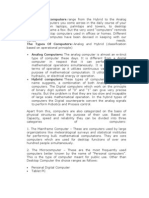Toward Higher Automation and Flexibility in Commercial Digital Photogrammetric System
Toward Higher Automation and Flexibility in Commercial Digital Photogrammetric System
Uploaded by
Kobalt von KriegerischbergCopyright:
Available Formats
Toward Higher Automation and Flexibility in Commercial Digital Photogrammetric System
Toward Higher Automation and Flexibility in Commercial Digital Photogrammetric System
Uploaded by
Kobalt von KriegerischbergOriginal Title
Copyright
Available Formats
Share this document
Did you find this document useful?
Is this content inappropriate?
Copyright:
Available Formats
Toward Higher Automation and Flexibility in Commercial Digital Photogrammetric System
Toward Higher Automation and Flexibility in Commercial Digital Photogrammetric System
Uploaded by
Kobalt von KriegerischbergCopyright:
Available Formats
Toward Higher Automation and Flexibility In Commercial Digital Photogrammetric System
Younian Wang, Xinghe Yang, Mladen Stojic, Brad Skelton Leica Geosystems, GIS & Mapping Division 2801 Buford Highway, Atlanta, GA, USA younian.wang@gis.leica-geosystems.com IC WG II/IV KEY WORDS: Digital, Photogrammetry, Mapping, Software, Softcopy, Automation, Algorithms, GIS. ABSTRACT After about 20 years research and development in digital photogrammetric systems, commercial software systems have become more and more powerful and capable of solving most photogrammetric mapping problems. On the other hand, user demands for higher automation and more flexibility for digital photogrammetric systems keep increasing, especially with the use of various new high-resolution airborne and space-borne cameras. In order to meet the market demands and challenge, a new digital photogrammetric system has been developed. It is called Leica Photogrammetry Suite. This paper introduces the major characteristics and functionality o f Leica Photogrammetry Suite. The various techniques to increase the automation and productivity are introduced. The design philosophy and implementation strategy for ease-of-use and high flexibility are explained. The powerful features for sensor modelling, DTM extraction and editing, and cartographic feature collection are introduced. The algorithms for automatic interior orientation, automatic point measurement, automatic DTM extraction, and automatic image mosaic are demonstrated. Several examples and independent test results show that Leica Photogrammetry Suite is a powerful and reliable digital photogrammetric system for both advanced photogrammetrists and GIS professionals.
INTRODUCTION
After about 20 years research and development in digital photogrammetric systems, commercial software systems become more and more powerful and capable of solving most photogrammetric mapping problems. On the other hand, user demands for higher automation and more flexibility for digital photogrammetric systems keep increasing, especially with the use of various new high-resolution airborne and space-borne cameras. In order to meet the market demands and challenge, Leica Geosystems GIS & Mapping division has developed a new digital photogrammetric workstation called Leica Photogrammetry Suite (LPS). It has used the previous product OrthoBASE as a foundation, and added many new modules and functionality and boosted both quality and performance. It can handle a very wide range of image sources such as scanned or digital frame camera image, IKONOS, QuickBird, SPOT, IRS-1C, EROS, Aster, and many more. Based on sensor geometry and available meta-data, there are many sensor models to choose from, including single perspective camera model, orbital pushbroom sensor model, polynomial-based pushbroom model, and rational functions based sensor model. A mixed sensor model is also supported in LPS. The functionality of Leica Photogrammetry Suite
imagery into usable spatial data. LPS consists a core part and several add-on modules. The major functions of the core include project setup, sensor modeling, control point measurement, automatic tie point collection, triangulation, automatic terain model extraction, orthorectification and mosaicking as shown in Fig. 1. The add-on modules consist of stereoscopic terrain editing, ORIMA orientation management and triangulation, PRO600 stereo feature collection for Microstation, GPro ADS40 image ground processing station, Image Equalizer, GeoVault image database, StereoAnalyst feature collection for ArcGIS etc. Fig. 2 shows these modules in an architectural relationship.
Terrain Editor
StereoAnalyst
GPro
PRO600
ORIMA
Image Equalizer
LPS STEREO LPS CORE
GeoVault
LPS CORE
Project Definition
Sensor Modeling
Point Measurement
Auto. Tie Collection
Figure 2: LPS Core and add-on modules In this shortened paper only some of the automation functions of LPS will be explained and demonstrated. 2 AUTOMATIC INTERIOR ORIENTATION
Block Triangulation
Auto. DTM Extraction
Ortho Rectification
Figure 1: LPS CORE functional modules covers all aspects that users may need to convert geo-spatial
Automatic interior orientation is necessary for scanned aerial frame camera photographs to establish the relationship between image and the internal camera film coordinates. The major work here is to measure the coordinates of fiducial marks. In
order to increase users productivity it is important to automatically recognize and measure the fiducial marks. In LPS a new module has been implement ed to recognize and measure the fiducial marks automatically and precisely. Instead of creating a fiducial template database, user has only to approximately measure one fiducial mark at the beginning. Then the software will go through each image in the whole project and find all the fiducial marks automatically. The underlying algorithm is a least square template matching. Therefore the fiducial marks can be found very accurately. Figure 4a: A registered aerial image (left) and a raw SPOT image (right) with 2 manual tie points
(a)
(b)
Figure 4b: Automatically found tie points displayed on their corresponding images (c) Figure 3: Automatic Fiducial Measurement. (a) Manually measure one fiducial mark, (b) Automatically measured fiducial Mark with least square template matching, (c) All automatically measured fiducial marks in a strip. An example is shown in Fig. 3. By using some optimization procedures such as dynamic template size determination, robust fiducial location estimation and hierarchical search, the automatic fiducial measurement process is also very fast. Each image can be finished just in a few seconds with a normal desktop PC. 3 AUTOMATIC POINT MEASUREMENT
Figure 4c: Enlarged view of three found tie points in their original scale and orientation some initial information about the scale and rotation, then the software will find many accurate tie points for these two images automatically. 4 BLOCK TRIANGULATION
Automatic point measurement (APM) includes automatic assistance of ground control point measurement, automatic tie point collection over entire block or sub-block and automatic tie point transfer from one image or sub-block to another. The APM procedure of LPS includes block connection to set up the relationship between images, feature extraction and matching, and robust gross error checking and least square correlation. The APM algorithms are independent of sensor type; therefore it works not only with images from aerial cameras, but also with images from digital cameras, non-metric cameras and satellite sensors. Furthermore it is also tolerant of large scale and rotation variations. Therefore the LPS APM can not only be used to connect image blocks for triangulation, it can also be used for various registration purposes, e.g. automatic image warping. The example shown in Fig. 4 demonstrates one of these applications. The left image is a registered aerial photograph; the right image is a SPOT image without any orientation information. These two images have a significant orientation difference and a scale difference about 1: 5.5. They have only a small overlap. The LPS APM can find tie points for this application. The u ser only needs to measure two tie points manually and approximately in order to give the software
LPS has a core triangulation package and an add-on triangulation module called ORIMA. The core triangulation can handle block triangulation for frame camera geome try, orbital pushbroom geometry and generic sensor geometry. Selfcalibration and robust gross error detection are available in both packages. ORIMA is an extensive triangulation package with stereo point measurement, rigorous GPS/IMU support, advanced error handling and rich residual analysis tools.
Figure 5: ORIMA stereo point measurement interface and graphic point and image connection display
Fig. 5 shows an ORIMA stereo point measurement interface and graphical point and image display. 5 AUTOMATIC DTM EXTRACTION
Automatic generation of terrain models from overlapped images is currently the most important way to collect a DTM. The DTM extraction module in LPS concentrates on improving the reliability, speed and productivity of the DTM extraction process. In order to improve reliability and speed, an integrated image matching strategy is developed. It includes a featuresupported image correlation, geometric constraints, hierarchical point search, on-the-fly resampling for rotation and distortion compensation, consistency checking etc. For m i proving speed and productivity, the DTM module can generate DTMs for all overlapped pairs in the block with the option to automatically mosaic them into a single optimized output. For further flexibility, some easy-to-use graphical interface and tools ar e developed, with which a user can manipulate their image pairs and different interest areas such as excluding regions and strategy parameters very easily and efficiently. It supports variety of input image formats and many output DTM types such as TIN, raster DEM, ESRI 3D shapefile and ASCII. Furthermore, The LPS DTM extraction module works for
ground points available for the test. LPS APM works well using the provided approximate coordinates of image photographic center. It generates 437 object points with 1477 image points. The triangulation computation includes automatic gross error detection and 4 additional parameters. 8 of the 14 known ground points are set to be GCPs and the remaining 6 are used as check points. The root mean square error of 6 check points is 0.041, 0.054 and 0.055 meters for X, Y, Z respectively. The Figure 6a shows the graphic display of the triangulation results. It is the footprint of the block with ground point positions and residual vectors. The triangle symbol represents GCPs, the circle symbol represents check points, and the rectangle symbol represents the automatically collected tie points. (Since the residuals of GCPs and check points are very sm all, they are difficult to see on the reduced graphic.) Considering the realistic conditions of the block, the accuracy of the triangulation results looks very reasonable. Figure 6b shows the automatically extracted DEM for the whole 28 images with ground cell size 1x1 meters. The whole automatic DEM extraction computation takes less than 30 minutes for 28 images on an ordinary Pentium 4 with 2.4GHz Laptop PC. Using 383 triangulated tie points (excluding the tie points outside DEM boundary and on buildings and trees) as ground check points, the automatic DEM has accuracy about 0.2 meters. The result shows the automatic DEM process is very fast and accurate. 6 SUMMARY
Figure 6a: Graphic overview of the block layout with GCPs, check points and automatically collected tie points
This paper has introduced a new digital photogrammetric workstation, namely Leica Photogrammetry Suite. Its main functional modules and system workflow are described. The features and algorithms for sensor modeling, automatic interior orientation, automatic point measurement, block triangulation and automatic DTM extraction of different kinds of images are introduced. Several examples are demonstrated. It shows a powerful, production oriented, process driven and easy to use digital photogrammetric workstation is ready to use for both advanced photogrammetrists and GIS professionals to accurately and efficiently convert their geospatial imagery into usable geospatial data. ACKNOWLEDGMENTS AND REFERNENCES
To be added.
Figure 6b: Automatically extracted DEM for the whole block with grid size 1x1 meters without any editing all aerial images, digital camera images, video camera images and satellite images, which offers excellent economy for the customer s. Fig. 6 shows an example of a 28-image block used in the OEEPE test. It covers an area of the town Forssa in Southern Finland. The image scale is 1:4000 and flight height is about 600 meters. The image overlap in strip is 60% and side overlap varies from 24% to 49%. The film is positive color and is scanned as black and white. The pixel size is 30 micrometers; each scanned image has 8000x8000 pixels. There are 14 known
You might also like
- How To Troubleshoot An Error 77 in DevicenetDocument12 pagesHow To Troubleshoot An Error 77 in DevicenetJuscelio Damascena0% (1)
- Implementing Win Server 2008 On HP ProliantDocument26 pagesImplementing Win Server 2008 On HP ProliantSupriyanto Bin PraptoutomoNo ratings yet
- Pitman Shorthand Book PDFDocument3 pagesPitman Shorthand Book PDFHamza SulehriaNo ratings yet
- Nokia 7360 ISAM FX: FeaturesDocument3 pagesNokia 7360 ISAM FX: Featuresit4728No ratings yet
- Multi 20 SensorDocument9 pagesMulti 20 SensorMemory KambaNo ratings yet
- 097 Software PDFDocument12 pages097 Software PDFKobalt von KriegerischbergNo ratings yet
- A Machine Vision System For Real-Time Automated Gear Fatigue Pitting DetectionDocument4 pagesA Machine Vision System For Real-Time Automated Gear Fatigue Pitting DetectionVarthini RajaNo ratings yet
- Wa0028.Document8 pagesWa0028.NaveenNo ratings yet
- Implementation and Optimization of Embedded Image Processing SystemDocument6 pagesImplementation and Optimization of Embedded Image Processing SystemGraceNo ratings yet
- The Research and Development of Measurement Robot Automatic Monitoring SystemsDocument4 pagesThe Research and Development of Measurement Robot Automatic Monitoring SystemsInternational Journal of computational Engineering research (IJCER)No ratings yet
- ThesisDocument51 pagesThesisPROJECT POINTNo ratings yet
- The Real Time Vechicle License Plate Identification System: P.Mohan Kumar, P.Kumaresan, Dr.S.A.K.JilaniDocument5 pagesThe Real Time Vechicle License Plate Identification System: P.Mohan Kumar, P.Kumaresan, Dr.S.A.K.JilaniIJERDNo ratings yet
- A Simulation Tool For Evaluating Digital Camera Image QualityDocument8 pagesA Simulation Tool For Evaluating Digital Camera Image QualityTùng NguyễnNo ratings yet
- Modern Mobile MappingDocument12 pagesModern Mobile Mappingn.ragavendiran100% (1)
- PDF/JCSSP 2012 528 532Document5 pagesPDF/JCSSP 2012 528 532mohitegaurv87No ratings yet
- Robot VisionDocument6 pagesRobot VisionHaydee Tu Ya SabesNo ratings yet
- Image Processing Applied To TrafficDocument13 pagesImage Processing Applied To TrafficDivya SreeNo ratings yet
- Computer Aided Spur Gear Data Extraction Based On Image Processing TechniqueDocument12 pagesComputer Aided Spur Gear Data Extraction Based On Image Processing TechniqueAli AbbarNo ratings yet
- Computer Vision System ToolboxDocument10 pagesComputer Vision System ToolboxClaudia Angélica Rivera RomeroNo ratings yet
- Shi Final ReportDocument12 pagesShi Final ReportMohamed SaeedNo ratings yet
- DEPTH MAPstereo-Pair VideoDocument7 pagesDEPTH MAPstereo-Pair VideoNk OsujiNo ratings yet
- Orthomosaic From Generating 3D Models With PhotogrammetryDocument13 pagesOrthomosaic From Generating 3D Models With PhotogrammetryInternational Journal of Innovative Science and Research TechnologyNo ratings yet
- Smart Cameras in Embedded SystemsDocument8 pagesSmart Cameras in Embedded SystemsVivekSonkerNo ratings yet
- Match ATDocument6 pagesMatch ATAzedine BatteurNo ratings yet
- Unit 3Document8 pagesUnit 3D Babu KosmicNo ratings yet
- Beating C in Scientific Computing Applications: On The Behavior and Performance of L, Part 1Document12 pagesBeating C in Scientific Computing Applications: On The Behavior and Performance of L, Part 1cluxNo ratings yet
- 5614sipij05 PDFDocument20 pages5614sipij05 PDFsipijNo ratings yet
- Motion Detection Application Using Web CameraDocument3 pagesMotion Detection Application Using Web CameraIlham ClinkersNo ratings yet
- Recognition of Number Plate in Car Parking System: ObjectiveDocument9 pagesRecognition of Number Plate in Car Parking System: ObjectiveVinod HandiNo ratings yet
- Machine Vision System (MEE6043) : Recognition of Number Plate in Car Parking SystemDocument9 pagesMachine Vision System (MEE6043) : Recognition of Number Plate in Car Parking SystemVinod HandiNo ratings yet
- Computer Vision Toolbox (Matlab)Document10 pagesComputer Vision Toolbox (Matlab)Hotland SitorusNo ratings yet
- E3sconf Gi2021 04001Document9 pagesE3sconf Gi2021 04001CEO DimejiNo ratings yet
- Real-Time Stereo Vision For Urban Traffic Scene UnderstandingDocument6 pagesReal-Time Stereo Vision For Urban Traffic Scene UnderstandingBasilNo ratings yet
- 3.KRS036 Final SubmissionDocument6 pages3.KRS036 Final SubmissionAravind MikeNo ratings yet
- RDS - Realistic Dynamic Simulation of RobotsDocument16 pagesRDS - Realistic Dynamic Simulation of RobotsstefanantonerNo ratings yet
- Automatic Image Registration Using MATLAB Simulink Model Configured On DM6437EVM ProcessorDocument4 pagesAutomatic Image Registration Using MATLAB Simulink Model Configured On DM6437EVM ProcessorAnonymous gF0DJW10yNo ratings yet
- Digital PhotogrammetryDocument14 pagesDigital Photogrammetrykirana100% (2)
- Digital Photogrammetry; An IntroductionDocument4 pagesDigital Photogrammetry; An Introductionoladokunodunayo870No ratings yet
- Chapter 4Document8 pagesChapter 4SAsuke UchihANo ratings yet
- Serief 2009Document5 pagesSerief 2009Eduardo VasquezNo ratings yet
- Synthetic Aperture Radar (SAR) Imaging UsingGlobal Back Projection (GBP) Algorithm ForAirborne Radar SystemsDocument6 pagesSynthetic Aperture Radar (SAR) Imaging UsingGlobal Back Projection (GBP) Algorithm ForAirborne Radar SystemsAshish BhardwajNo ratings yet
- Ultra Cam Eagle, Understanding The New SensorDocument6 pagesUltra Cam Eagle, Understanding The New Sensorraintree1980No ratings yet
- Unit 2: - Introduction To Machine VisionDocument4 pagesUnit 2: - Introduction To Machine VisionProphet TempestNo ratings yet
- Computer Graphics Lab ManualDocument54 pagesComputer Graphics Lab Manualjohnhaile23No ratings yet
- Real-Time Detection of Colored Objects in Multiple Camera Streams With Off-the-Shelf Hardware ComponentsDocument10 pagesReal-Time Detection of Colored Objects in Multiple Camera Streams With Off-the-Shelf Hardware ComponentsUsman AsadNo ratings yet
- V. (PP 25-28) ABDUL Manan - Implementation of Image Processing Algorithm On FPGA - 24.2.11Document5 pagesV. (PP 25-28) ABDUL Manan - Implementation of Image Processing Algorithm On FPGA - 24.2.11Nguyen Tuong ThanhNo ratings yet
- CG Lab InfoDocument16 pagesCG Lab InfoMohammed Adnan khanNo ratings yet
- 15CSL68 - Computer Graphics Lab Manual: Mr. Shankar RDocument54 pages15CSL68 - Computer Graphics Lab Manual: Mr. Shankar RCharizard FreakNo ratings yet
- Vehicle License Plate Recognition Using Morphology and Neural NetworkDocument7 pagesVehicle License Plate Recognition Using Morphology and Neural NetworkJames MorenoNo ratings yet
- Design of Panoramic Mosaic Camera Based On FPGA Using Optimal Mosaic AlgorithmDocument8 pagesDesign of Panoramic Mosaic Camera Based On FPGA Using Optimal Mosaic Algorithmhanumantha12No ratings yet
- Literature Review On Different Compression TechniquesDocument5 pagesLiterature Review On Different Compression TechniquesInternational Journal of Application or Innovation in Engineering & ManagementNo ratings yet
- Geometric Aspects Concerning The Photogrammetric Workflow of The Digital Aerial Camera UltracamDocument6 pagesGeometric Aspects Concerning The Photogrammetric Workflow of The Digital Aerial Camera UltracamMano DragonNo ratings yet
- Vehicle Class Recognition Using 3D CG Models: Shirmila Mohottala, Masataka Kagesawa, Katsushi IkeuchiDocument10 pagesVehicle Class Recognition Using 3D CG Models: Shirmila Mohottala, Masataka Kagesawa, Katsushi IkeuchiRami RomeoNo ratings yet
- Amaitik Turkey PDFDocument9 pagesAmaitik Turkey PDFSalehNo ratings yet
- Ijcttjournal V1i2p9Document10 pagesIjcttjournal V1i2p9surendiran123No ratings yet
- Improved SIFT-Features Matching For Object Recognition: Emails: (Alhwarin, Wang, Ristic, Ag) @iat - Uni-Bremen - deDocument12 pagesImproved SIFT-Features Matching For Object Recognition: Emails: (Alhwarin, Wang, Ristic, Ag) @iat - Uni-Bremen - dethirupathiNo ratings yet
- Hand Gesture Recognition in Images and Video: Ilan Steinberg, Tomer M. London, Dotan Di CastroDocument21 pagesHand Gesture Recognition in Images and Video: Ilan Steinberg, Tomer M. London, Dotan Di CastroSukh VirNo ratings yet
- SIFT Feature MatchingDocument12 pagesSIFT Feature MatchingethanrabbNo ratings yet
- A Faster Image Registration and StitchingDocument4 pagesA Faster Image Registration and StitchingVasuhi SamyduraiNo ratings yet
- Marker-Based Monocular VisionDocument8 pagesMarker-Based Monocular VisionbazookavnitNo ratings yet
- Mini Project DocumentationDocument38 pagesMini Project DocumentationAbhijith GuptaNo ratings yet
- (John C Russ) The Image Processing Cookbook (B-Ok - Xyz)Document108 pages(John C Russ) The Image Processing Cookbook (B-Ok - Xyz)getinetNo ratings yet
- Motion Estimation: Advancements and Applications in Computer VisionFrom EverandMotion Estimation: Advancements and Applications in Computer VisionNo ratings yet
- Architecture-Aware Optimization Strategies in Real-time Image ProcessingFrom EverandArchitecture-Aware Optimization Strategies in Real-time Image ProcessingNo ratings yet
- 240 Spatial 2 PDFDocument6 pages240 Spatial 2 PDFKobalt von KriegerischbergNo ratings yet
- 202 7 Arqueo PDFDocument6 pages202 7 Arqueo PDFKobalt von KriegerischbergNo ratings yet
- Exterior Orientation For Remote Sensing Image With High Resolution by Linear FeatureDocument4 pagesExterior Orientation For Remote Sensing Image With High Resolution by Linear FeatureKobalt von KriegerischbergNo ratings yet
- 216 Spatial 2 PDFDocument3 pages216 Spatial 2 PDFKobalt von KriegerischbergNo ratings yet
- RS-techniques For Land Use Change Detection - Case Study of IstanbulDocument6 pagesRS-techniques For Land Use Change Detection - Case Study of IstanbulKobalt von KriegerischbergNo ratings yet
- Strategies For Updating A National 3-D Topographic Database and Related GeoinformationDocument6 pagesStrategies For Updating A National 3-D Topographic Database and Related GeoinformationKobalt von KriegerischbergNo ratings yet
- Automatic Change Detection For Validation of Digital Map DatabasesDocument6 pagesAutomatic Change Detection For Validation of Digital Map DatabasesKobalt von KriegerischbergNo ratings yet
- 177 7 PDFDocument5 pages177 7 PDFKobalt von KriegerischbergNo ratings yet
- Gps/Ins Systems For Compilation of Digital Large-Scale OrthophotosDocument6 pagesGps/Ins Systems For Compilation of Digital Large-Scale OrthophotosKobalt von KriegerischbergNo ratings yet
- Accuracy of DTM Generated From Spot 4 and Spot 5 Hrs Data: Commission IV, WG IV/6Document5 pagesAccuracy of DTM Generated From Spot 4 and Spot 5 Hrs Data: Commission IV, WG IV/6Kobalt von KriegerischbergNo ratings yet
- 086 7 PDFDocument5 pages086 7 PDFKobalt von KriegerischbergNo ratings yet
- 9.2.1.10 Packet Tracer Configuring Standard ACLs Instructions IG - Alexis PedrozaDocument8 pages9.2.1.10 Packet Tracer Configuring Standard ACLs Instructions IG - Alexis Pedrozaalexis pedrozaNo ratings yet
- Rsusr Dbms UsersDocument3 pagesRsusr Dbms Usersshankar agarwalNo ratings yet
- Fire Control Panel: Cerberus™ PRODocument18 pagesFire Control Panel: Cerberus™ PROTamer MahmodNo ratings yet
- The Types of Computers: Analog and Hybrid (Classification Analog Computers: The Analog Computer Is Almost An ExtinctDocument23 pagesThe Types of Computers: Analog and Hybrid (Classification Analog Computers: The Analog Computer Is Almost An ExtinctPurushotham AchariNo ratings yet
- Panasonic Label PDFDocument1 pagePanasonic Label PDFAnonymous tbssIg9TrNo ratings yet
- User Manual - EcgAUTO v3.0 Rev1 - April 2012Document310 pagesUser Manual - EcgAUTO v3.0 Rev1 - April 2012Christian Wahl100% (1)
- ws17 Tutorial Ntop PresDocument122 pagesws17 Tutorial Ntop Preshuonz mrNo ratings yet
- Embedded Ide - VdsplinkDocument259 pagesEmbedded Ide - Vdsplinkravikumar_chNo ratings yet
- Spectrum Refarming - Google SearchDocument1 pageSpectrum Refarming - Google SearchHortence SiuNo ratings yet
- CT-S281 Data SheetDocument2 pagesCT-S281 Data SheetarrowheadcorpNo ratings yet
- + and MSA6800+ A-Series: MXA6800 Analog Audio Multiplexers and Analog Audio Multiplexers With SynchronizerDocument92 pages+ and MSA6800+ A-Series: MXA6800 Analog Audio Multiplexers and Analog Audio Multiplexers With SynchronizerTechne PhobosNo ratings yet
- Tutorial From RNODocument2 pagesTutorial From RNOquens884No ratings yet
- Akij UddinDocument7 pagesAkij UddinIyyappan .vNo ratings yet
- K7VM2-R30 UmDocument29 pagesK7VM2-R30 UmSyed Irfan BashaNo ratings yet
- IS473 Distributed Systems: Distributed Objects & Remote InvocationDocument29 pagesIS473 Distributed Systems: Distributed Objects & Remote Invocationtp2006sterNo ratings yet
- The Philosophy BookDocument8 pagesThe Philosophy BookanezaNo ratings yet
- Gifi ReportDocument11 pagesGifi ReportAvinash Sriramula100% (2)
- BMW Scanner 136 AnglaisDocument13 pagesBMW Scanner 136 AnglaiskolosrodosNo ratings yet
- Low Power ROMDocument12 pagesLow Power ROMLucas WeaverNo ratings yet
- Mini Hi-Fi System: FWP3200D/05/12/93/85Document53 pagesMini Hi-Fi System: FWP3200D/05/12/93/85JorgeBaquéNo ratings yet
- How To Use The Blur, Sharpen, and Smudge Tool Adobe Photoshop CS5Document6 pagesHow To Use The Blur, Sharpen, and Smudge Tool Adobe Photoshop CS5imadprNo ratings yet
- PIC18F458PPTDocument58 pagesPIC18F458PPTdgkanade72No ratings yet
- Top 10 Recommendations UWLDocument96 pagesTop 10 Recommendations UWLFabrizio VendittiNo ratings yet
- Suresh Kumar - 3.7 Yrs - Tibco Developer+java - Mphasis - ChennaiDocument3 pagesSuresh Kumar - 3.7 Yrs - Tibco Developer+java - Mphasis - Chennaisabarin_72No ratings yet
- 6 Security TetraDocument20 pages6 Security TetraRicardo Agustín SolalindeNo ratings yet
- ZXR10 5900&5200 Series - Product DescriptionDocument77 pagesZXR10 5900&5200 Series - Product DescriptionJesus RosalesNo ratings yet













